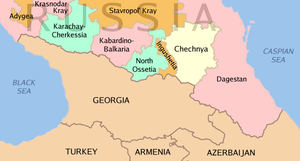Countries which invade or occupy others can expect some push back. Sometimes that push back takes the form of terrorism.
The Caucasus region of Central Asia is a truly fascinating one. For instance, we use the word ‘Caucasian’ to describe those whose skin colour we see as ‘white’ (although not a very accurate term). I also remember from my days teaching linguistics at Carleton University in Ottawa that Caucasian languages are wonderfully complex. Finally, from an ethnographic perspective, the area is associated with proud, fierce peoples and it is generally best not to mess with them.

Russia for one does not seem to have realised that.
This part of Asia vacillated between Persian and Russian Imperialist rule in recent history. Later, the Soviet Union banished close to one million Chechens and other nationalities in the region during WWII to Central Asia and Siberia, resulting in the deaths of hundreds of thousands.
Political violence in this area is not new. Tsarist interference in Chechnya saw the rise of Shaikh Shamil, Imam of Dagestan and Chechnya, who led forces against the Russians in the 19th century. He could be called an early Caucasian ‘freedom fighter’.
The Siege of Grozny
Fast foward to the 1990s. In the heady days of the dissolution of the Soviet Union Chechnya declared independence but the newly formed Russian Federation wanted nothing of the sort. It backed Ingushetian forces which had decided to stick with the Federation leading to what is called the First Chechen War.
The Second Chechen War, technically from 1999 to 2009 although unrest is still high, brought in a jihadist element. Russian forces besieged the Chechen capital Grozny over the winter of 1999-2000 and the death toll was catastrophic. While Chechen regular forces fought the Russians there was also a terrorist element that sought to sway opinion.
Shamil Basayev
In addition to guerrilla tactics, a classic move when inferior forces meet superior ones, terrorists began to conduct suicide operations. The inspiration for many Chechen jihadis was Shamil Basayev, who was in fact named after the aforementioned Imam Shamil of the 19th century. He did not disappoint his ancestor in his efforts to protect Chechen interests.
2003 Red Square bombing
One such suicide attack transpired on this day in 2003 in iconic Red Square in Moscow. A female bomber detonated her explosive device, killing six and wounding 44. It was later determined that Khadishat Mangarieva was the widow of a Chechen fighter and may actually have been seeking to target the Duma (the Russian Parliament) before her bomb went off prematurely. Women of this group later were given the label ‘Black Widows‘.
This attack was one of many in Russia during the 1990s and 2000s. The series of incidents can be directly connected to Russian interference in the affairs of another state. Terrorism often stems from such moves and history is replete with examples.
When will Russia learn this? Its recent action in Crimea and eastern Ukraine suggests the answer is – not yet.
